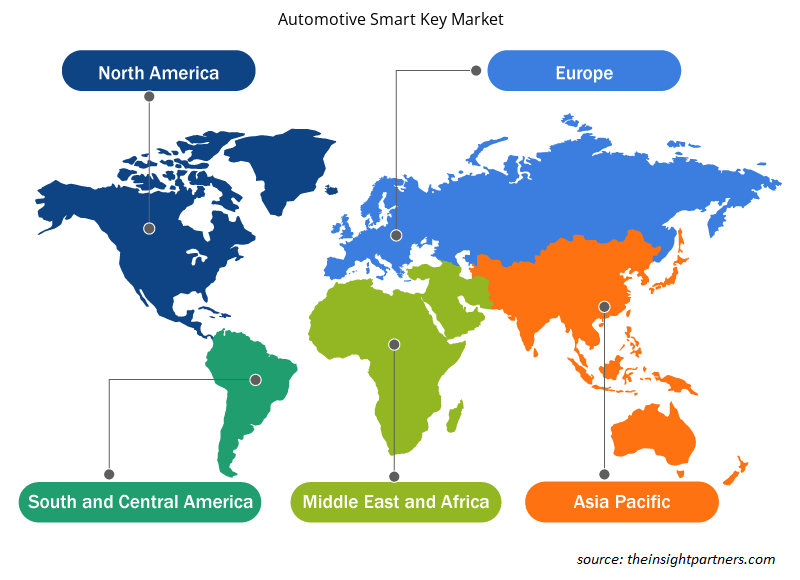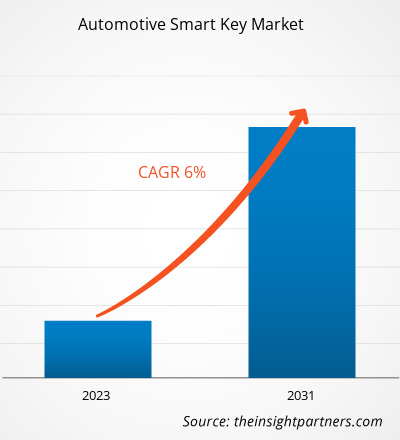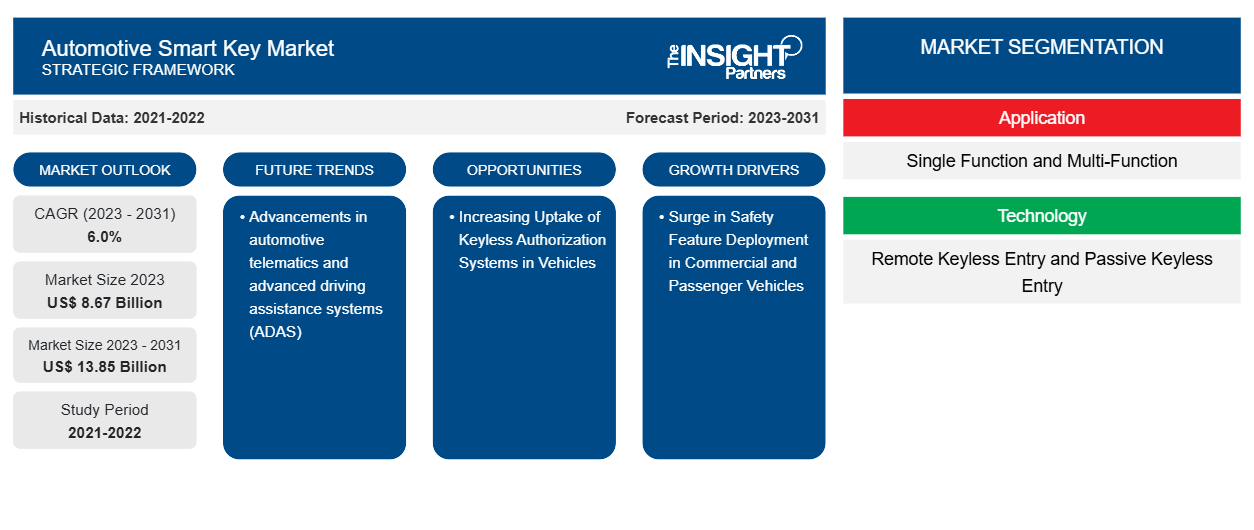Der Markt für intelligente Autoschlüssel soll von 8,67 Milliarden US-Dollar im Jahr 2023 auf 13,85 Milliarden US-Dollar im Jahr 2031 anwachsen. Der Markt soll zwischen 2023 und 2031 eine durchschnittliche jährliche Wachstumsrate von 6,0 % verzeichnen. Die Fortschritte in der Automobiltelematik und bei fortschrittlichen Fahrassistenzsystemen (ADAS) dürften weiterhin wichtige Trends auf dem Markt bleiben.
Marktanalyse für intelligente Autoschlüssel
Der weltweite Anstieg der Produktion von Luxusautos dürfte im Prognosezeitraum das Wachstum des Marktes für intelligente Autoschlüssel ankurbeln. Darüber hinaus dürfte der zunehmende Einsatz von Sicherheitsfunktionen in Nutzfahrzeugen und Personenkraftwagen die Nachfrage nach intelligenten Autoschlüsseln ankurbeln, was wiederum das Marktwachstum im analysierten Zeitraum ankurbeln dürfte. Darüber hinaus dürfte die zunehmende Verbreitung schlüsselloser Autorisierungssysteme in Fahrzeugen Chancen für die Unternehmen schaffen, die auf dem Markt für intelligente Autoschlüssel tätig sind.
Marktübersicht für Smart-Keys für Kraftfahrzeuge
Die Infrastruktur des Marktes für Smart-Keys für Autos besteht hauptsächlich aus Hardware-/Komponentenanbietern, Smart-Key-Herstellern, Systemintegratoren und Endnutzern. Ein Smart-Key für Autos kombiniert verschiedene Hardwarekomponenten wie Sensoren, Mikroprozessoren , Metallschlüssel und Abdeckboxen. Wichtige Akteure nehmen bedeutende Positionen in den verschiedenen Knotenpunkten des Ökosystems des Marktes für Smart-Keys für Autos ein. Die Hardware für Smart-Keys für Autos besteht unter anderem aus Mikrocontrollern, Hochfrequenzmodulen, Stromversorgung, Sendern, Türsteuermodulen und Schalttafeln. Die Komponentenanbieter liefern das Material zum Bau der Hardware für Smart-Keys für Autos. Die Smart-Key-Hersteller führen dann verschiedene Prozesse durch, wie Design, Montage und Produktion, um Rohmaterialien in fertige Produkte umzuwandeln. Systemintegratoren bringen die Komponentensubsysteme zusammen und sorgen dafür, dass sie effizient arbeiten.
Passen Sie diesen Bericht Ihren Anforderungen an
Sie erhalten kostenlose Anpassungen an jedem Bericht, einschließlich Teilen dieses Berichts oder einer Analyse auf Länderebene, eines Excel-Datenpakets sowie tolle Angebote und Rabatte für Start-ups und Universitäten.
-
Holen Sie sich die wichtigsten Markttrends aus diesem Bericht.Dieses KOSTENLOSE Beispiel umfasst eine Datenanalyse von Markttrends bis hin zu Schätzungen und Prognosen.
Treiber und Chancen auf dem Automotive Smart Key-Markt
Starke Integration von Sicherheitsfunktionen in Nutzfahrzeuge und Personenkraftwagen begünstigt den Markt
Die steigende Nachfrage nach der Integration von Sicherheitsfunktionen in moderne Fahrzeuge treibt den Markt für intelligente Autoschlüssel voran. Die zunehmende Zahl von Autodiebstählen hat die Nachfrage nach verbesserten Systemen mit einem einzigartigen Code zum Entriegeln des Autos erhöht, bei denen eine elektronische Schlüsselanhängererkennung durch eine Codeautorisierung erfolgt. Infolgedessen begannen Automobilhersteller, computerverschlüsselte Mikrochips in ihren schlüssellosen Systemen zu verwenden, um die Sicherheitsebenen zu verbessern, die das Marktwachstum vorantreiben. Der Anstieg von Hybrid- und Elektrofahrzeugen, die mit technologisch fortschrittlichen Sicherheitsfunktionen ausgestattet sind, hat auch die Nachfrage nach intelligenten Schlüsseln erhöht. Beispielsweise ermöglicht Mercedes Keyless Go einem Fahrer, ein Fahrzeug zu ver- und entriegeln, ohne die entsprechenden Smart-Key-Tasten zu verwenden. Wenn der Fahrer mit einer Keyless Go SmartKey-Karte in ein Auto einsteigt, kann er den Motor starten und abstellen, ohne den Smart Key einstecken zu müssen. Technologische Fortschritte wie Getriebe und Infrarotsensoren werden voraussichtlich die Sicherheitsfunktionen verbessern und das Marktwachstum im Prognosezeitraum erheblich vorantreiben.
Zunehmende Verbreitung schlüsselloser Autorisierungssysteme in Fahrzeugen
Die Nachfrage nach aktiven und passiven schlüssellosen Zugangssystemen zum ferngesteuerten Ver- und Entriegeln und Starten des Automotors mithilfe von HF-Signalen ist deutlich gestiegen. Mechanische Schlüssel verhindern den unbefugten Zugang zu Autos. Moderne Fahrzeuge verwenden Mikrocontroller für Anwendungen wie passive schlüssellose Zugangssysteme und Fahrzeug-Wegfahrsperren. Eingebettete elektronische Systeme sind praktisch, die Systemsicherheit kann jedoch durch Diebstahl oder Fehler beim Scannen der drahtlosen Schnittstelle verletzt werden. Dieser Faktor hat zur Entwicklung eines schlüssellosen Zugangssystems für Autos mit Zwei-Faktor-Authentifizierung geführt, bei dem das Auto das benutzer- und gerätebasierte Schlüsselanhänger-Authentifizierungsframework autonom überprüfen kann, wodurch ein Zwei-Faktor-Authentifizierungssystem ermöglicht wird. Die aufkommenden Trends der Zwei-Faktor-Authentifizierung in schlüssellosen Autorisierungssystemen zur Verhinderung von Sicherheitsverletzungen und Hackerangriffen beflügeln den globalen Markt für intelligente Autoschlüssel. Eine hochmoderne Funktechnologie, ein innovatives schlüsselloses System sowie ein hochpräzises und störungsfreies Schlüsselortungssystem bieten Fahrern und Passagieren optimale Sicherheit und Komfort.
Segmentierungsanalyse des Automotive Smart Key-Marktberichts
Wichtige Segmente, die zur Ableitung der Marktanalyse für intelligente Autoschlüssel beigetragen haben, sind Anwendung und Technologie.
- Basierend auf der Anwendung ist der Markt für intelligente Autoschlüssel in Einzelfunktion und Multifunktion unterteilt. Das Einzelfunktionssegment hatte im Jahr 2023 den größeren Marktanteil.
- Nach Technologie ist der Markt in schlüssellose Fernzugriffssysteme und passive schlüssellose Zugangssysteme segmentiert. Das Segment der schlüssellosen Fernzugriffssysteme hatte im Jahr 2023 den größten Marktanteil.
Marktanteilsanalyse für Smart Keys für Kraftfahrzeuge nach geografischer Lage
Der geografische Umfang des Marktberichts für Smart-Keys für Kraftfahrzeuge ist hauptsächlich in fünf Regionen unterteilt: Nordamerika, Asien-Pazifik, Europa, Naher Osten und Afrika sowie Südamerika.
Der Umfang des Marktberichts für Smart-Keys für Kraftfahrzeuge umfasst Nordamerika (USA, Kanada und Mexiko), Europa (Deutschland, Frankreich, Italien, Spanien, Großbritannien und den Rest von Europa), den asiatisch-pazifischen Raum (China, Indien, Australien, Japan, Südkorea und den Rest des asiatisch-pazifischen Raums), den Nahen Osten und Afrika (Südafrika, Saudi-Arabien, Vereinigte Arabische Emirate und den Rest des Nahen Ostens und Afrikas) sowie Südamerika (Brasilien, Argentinien und den Rest von Südamerika). In Bezug auf den Umsatz dominierte der asiatisch-pazifische Raum im Jahr 2023 den Marktanteil für Smart-Keys für Kraftfahrzeuge. Europa war der zweitgrößte Umsatzträger zum globalen Markt für Smart-Keys für Kraftfahrzeuge, gefolgt von Nordamerika.
Regionale Einblicke in den Markt für intelligente Autoschlüssel
Die regionalen Trends und Faktoren, die den Automotive Smart Key-Markt während des gesamten Prognosezeitraums beeinflussen, wurden von den Analysten von Insight Partners ausführlich erläutert. In diesem Abschnitt werden auch die Marktsegmente und die Geografie des Automotive Smart Key-Marktes in Nordamerika, Europa, im asiatisch-pazifischen Raum, im Nahen Osten und Afrika sowie in Süd- und Mittelamerika erörtert.

- Erhalten Sie regionale Daten zum Markt für Smart-Keys für Kraftfahrzeuge
Umfang des Marktberichts für Smart Keys für Kraftfahrzeuge
| Berichtsattribut | Details |
|---|---|
| Marktgröße im Jahr 2023 | 8,67 Milliarden US-Dollar |
| Marktgröße bis 2031 | 13,85 Milliarden US-Dollar |
| Globale CAGR (2023 - 2031) | 6,0 % |
| Historische Daten | 2021-2022 |
| Prognosezeitraum | 2023–2031 |
| Abgedeckte Segmente |
Nach Anwendung
|
| Abgedeckte Regionen und Länder |
Nordamerika
|
| Marktführer und wichtige Unternehmensprofile |
|
Dichte der wichtigsten Akteure auf dem Automotive Smart-Markt: Die Auswirkungen auf die Geschäftsdynamik verstehen
Der Markt für Smart Keys für Kraftfahrzeuge wächst rasant. Dies wird durch die steigende Nachfrage der Endnutzer aufgrund von Faktoren wie sich entwickelnden Verbraucherpräferenzen, technologischen Fortschritten und einem größeren Bewusstsein für die Vorteile des Produkts vorangetrieben. Mit der steigenden Nachfrage erweitern Unternehmen ihr Angebot, entwickeln Innovationen, um die Bedürfnisse der Verbraucher zu erfüllen, und nutzen neue Trends, was das Marktwachstum weiter ankurbelt.
Die Marktteilnehmerdichte bezieht sich auf die Verteilung der Firmen oder Unternehmen, die in einem bestimmten Markt oder einer bestimmten Branche tätig sind. Sie gibt an, wie viele Wettbewerber (Marktteilnehmer) in einem bestimmten Marktraum im Verhältnis zu seiner Größe oder seinem gesamten Marktwert präsent sind.
Die wichtigsten auf dem Markt für Smart-Keys für Kraftfahrzeuge tätigen Unternehmen sind:
- ALPHA Corporation
- Continental AG
- Denso Corporation
- Honda Lock Mfg. Co., Ltd.
- Silca SpA
- Toyota Motor Corporation
Haftungsausschluss : Die oben aufgeführten Unternehmen sind nicht in einer bestimmten Reihenfolge aufgeführt.

- Überblick über die wichtigsten Akteure auf dem Markt für Smart-Keys für Kraftfahrzeuge
Neuigkeiten und aktuelle Entwicklungen zum Automotive Smart Key-Markt
Der Markt für intelligente Autoschlüssel wird durch die Erhebung qualitativer und quantitativer Daten nach Primär- und Sekundärforschung bewertet, die wichtige Unternehmensveröffentlichungen, Verbandsdaten und Datenbanken umfasst. Nachfolgend sind einige der Entwicklungen auf dem Markt für intelligente Autoschlüssel aufgeführt:
- HELLA hat eine neue digitale Autoschlüssel-Zugangslösung auf Basis der Ultrabreitband-Technologie für Pkw-OEMs vorgestellt. Dieser neue Smart Car Access bietet Nutzern mehr Komfort durch einen völlig freihändigen, Smartphone-basierten Fahrzeugzugang. (Quelle: HELLA GmbH, Pressemitteilung, Juni 2021)
- Silca SpA hat den Remote Vehicle Key TOY49R25 auf den Markt gebracht, eine neue Referenz für die Duplizierung von Funkschlüsseln für Autos, die mit Citroen, Peugeot und Toyota kompatibel sind: die ideale Lösung für den Ersatz beschädigter oder verlorener Originalschlüssel oder um im Notfall ein Duplikat zu haben. (Quelle: Silca SpA, Pressemitteilung, September 2021)
Marktbericht zu Smart Keys für Kraftfahrzeuge – Abdeckung und Ergebnisse
Der Bericht „Marktgröße und Prognose für Smart Keys im Automobilbereich (2021–2031)“ bietet eine detaillierte Analyse des Marktes, die die folgenden Bereiche abdeckt:
- Automotive Smart Key Marktgröße und Prognose auf globaler, regionaler und Länderebene für alle wichtigen Marktsegmente, die im Rahmen des Berichts abgedeckt sind
- Automotive Smart Key Markttrends sowie Marktdynamik wie Treiber, Einschränkungen und wichtige Chancen
- Detaillierte PEST- und SWOT-Analyse
- Analyse des Automotive-Smart-Key-Marktes mit wichtigen Markttrends, globalen und regionalen Rahmenbedingungen, wichtigen Akteuren, Vorschriften und aktuellen Marktentwicklungen
- Branchenlandschaft und Wettbewerbsanalyse, die die Marktkonzentration, Heatmap-Analyse, prominente Akteure und aktuelle Entwicklungen für den Markt für intelligente Autoschlüssel umfasst
- Detaillierte Firmenprofile
- Historische Analyse (2 Jahre), Basisjahr, Prognose (7 Jahre) mit CAGR
- PEST- und SWOT-Analyse
- Marktgröße Wert/Volumen – Global, Regional, Land
- Branchen- und Wettbewerbslandschaft
- Excel-Datensatz
Aktuelle Berichte
Erfahrungsberichte
Grund zum Kauf
- Fundierte Entscheidungsfindung
- Marktdynamik verstehen
- Wettbewerbsanalyse
- Kundeneinblicke
- Marktprognosen
- Risikominimierung
- Strategische Planung
- Investitionsbegründung
- Identifizierung neuer Märkte
- Verbesserung von Marketingstrategien
- Steigerung der Betriebseffizienz
- Anpassung an regulatorische Trends























 Kostenlose Probe anfordern für - Markt für intelligente Autoschlüssel
Kostenlose Probe anfordern für - Markt für intelligente Autoschlüssel